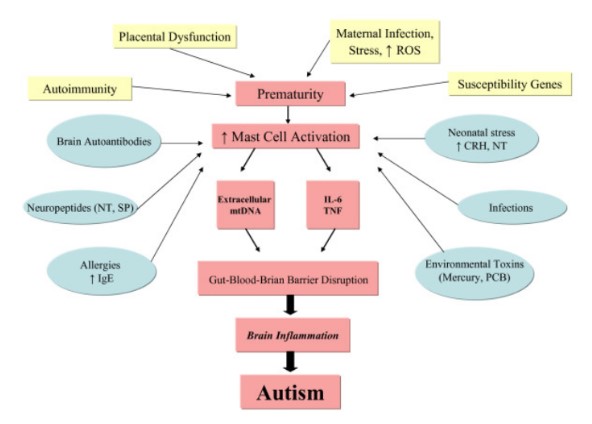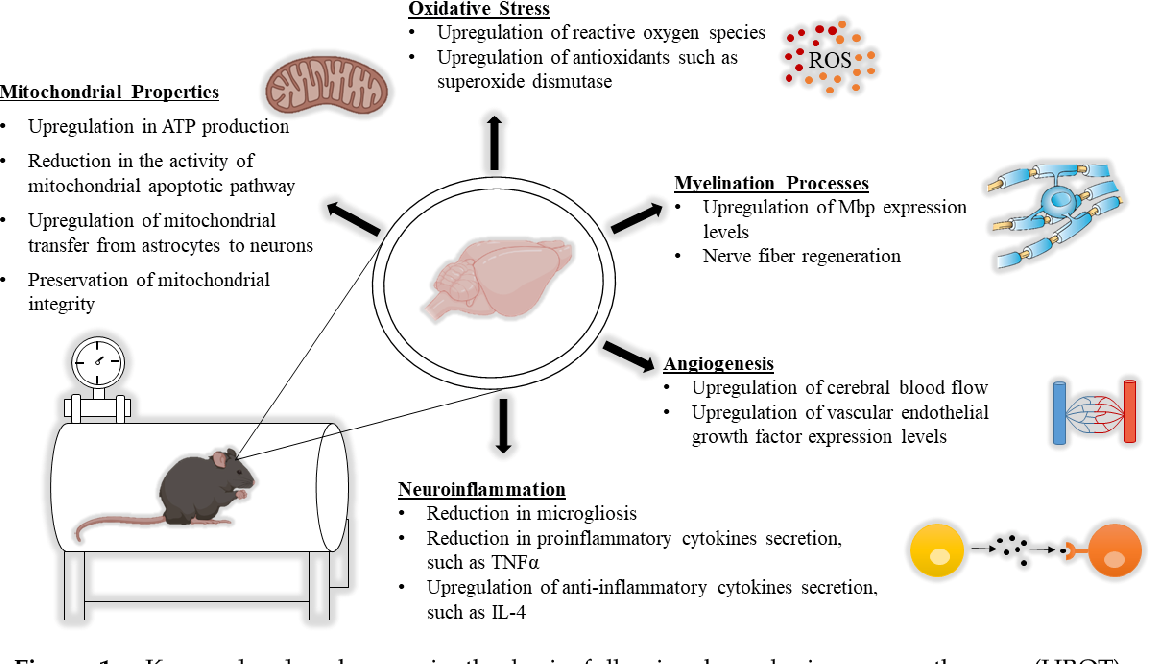Role of Hyperbaric Oxygen Therapy in Autism
Autism
Autism spectrum disorder is a developmental impairment that results from anomalies in the brain. Some ASD sufferers have a recognized distinction, like a genetic disorder. ASD is thought to have several underlying reasons that interact to alter how people typically develop.
What happens in people with ASD?
People with ASD usually behave, communicate, interact, and learn differently from most other persons. ASD usually manifests before the age of three and can last the rest of a person’s life, though symptoms occasionally become better with age. ASD symptoms can appear in some kids within the first year of life. Others might not experience symptoms until they are 24 months old or older. Some ASD children develop new skills and reach developmental milestones up until the age of 18 to 24 months, at which point they cease doing so or lose the abilities they previously possessed [1].
Signs and Symptoms of Autism
People mostly affected by autism show different signs and symptoms of the disease. CDC’s Autism & Developmental Disabilities Monitoring (ADDM) Network indicates that 1 in 44 kids has been diagnosed with autism spectrum disorder (ASD). According to parent reports, almost 1 in 6 (17%) children between the ages of 3 and 17 were identified as having a developmental disability between 2009 and 2017 [2].
- Lack of social communication
- Lack of interaction
- Restricted behaviours
- Develop unusual ways of learning and paying attention
- Low IQ
- Difficulty in making friends
- Speech disability
Diagnosis
Autism is diagnosed based on the behaviour shown by the child during development. The blood test is often recommended for the diagnosis of autism. To determine a diagnosis, doctors consider the child’s behaviour and developmental stage. ASD can occasionally be identified in children as young as 18 months. By the age of 2, a professional’s diagnosis may be trusted. However, many kids do not get a definitive diagnosis until they are older. Some patients do not receive a diagnosis until they are teenagers or adults [3]. People with ASD may not receive the early assistance they require because of this delay. Screening tests are recommended for different age groups to diagnose properly. During routine well-child visits at these ages, the American Academy of Pediatrics (AAP) advises developmental and behavioural screening for all kids:
- 9 months
- 1 year
- 3 years
Pathophysiology of ASD
Autism may develop after conception, according to research on genetic inheritance and neuroanatomical development. Children with autism tend to have larger heads and brains. Key brain areas with local overconnectivity due to an excess of neurons [4]. Early in pregnancy, there is disturbed neural migration. Excitatory-inhibitory networks that are out of balance may lead to ASD. Abnormal immunological activity at crucial stages of neurodevelopment is a factor in the development of some ASD subtypes. Autism has been associated with several neurotransmitter disorders, most notably elevated blood serotonin levels. It is uncertain if these result in structural or behavioural issues. It has been established that immunological dysregulation and GI disorders contribute to the parthenogenesis of autism [5]. An immunological imbalance may also result from recurrent GI illnesses and leads to ASD.

Risk Factors and Causes
Various risk factors can increase the risk of the child developing autism. Environmental, biological, and genetic factors are only a few of the many that have been shown to increase a child’s risk of having ASD.
- Genetic causes of ASD in the family
- Some genetic diseases such as tuber sclerosis or fragile X syndromeComplications during birth
- Lower birth weight
- Children born to over-aged parents
- Mutation in the CHD8 gene, allergies, environmental toxins, and dysregulation in immune response [6].

What therapies and treatments can be used for ASD?
The goal of current therapies for autism spectrum disorder (ASD) is to lessen symptoms that affect everyday life and quality of life. Several types of treatments are used for ASD patients.
1. Behavioural approaches
Behavioural techniques concentrate on altering behaviours by comprehending what takes place before and following the behaviour. The most effective methods for addressing ASD symptoms are behavioural ones. Applied Behavior Analysis is a well-known behavioural therapy for people with ASD (ABA). To enhance many skills, ABA promotes desired behaviours while discouraging undesirable ones. Progress is monitored and quantified.
2. Developmental Approaches
Developmental approaches concentrate on enhancing a narrow range of interconnected developmental abilities, such as language skills or motor skills, or a broader range of developmental abilities. Behavioural and developmental techniques are frequently integrated. For those with ASD, speech and language therapy is the most popular developmental therapy. The person’s comprehension and use of speech and language are both improved by speech and language therapy. The goals of occupational therapy is to help the patient live as independently as feasible. Dressing, eating, taking a shower, and interacting with others are examples of skills.
3. Educational Approaches
Treatments for education are provided in a classroom setting. The Treatment & Education of Autistic and Related Communication-Handicapped Children (TEACCH) approach is one form of educational strategy. The foundation of TEACCH is the notion that persons with autism benefit from consistency and visual learning. It gives teachers options for changing the setup of the classroom to enhance academic and other results.
4. Social Relational Approaches
The goals of social-relational therapies are to increase social competence and foster close relationships. Parents or peer mentors may be used in several social-relational strategies.
5. Pharmacological Approaches
The primary signs and symptoms of ASD cannot be treated by medicine. Co-occurring symptoms are treated with several drugs, which can improve ASD patients’ functioning. For instance, medication may be used to regulate excessive energy, difficulty concentrating, or self-destructive tendencies like head banging or hand biting. Medication can be used to treat medical diseases including seizures, sleep disorders, and stomach or other gastrointestinal issues in addition to co-occurring psychological conditions like anxiety or depression.
Hyperbaric Oxygen as Effective Medicine for Autism
By applying pure oxygen at high pressure (about 2-3 atmospheres), hyperbaric oxygen treatment (HBOT) increases the amount of oxygen in the blood and tissues (Hyperoxia). Hyperbaric oxygen therapy (HBOT), a type of treatment, involves being exposed to pure oxygen (O2) concentrations at high atmospheric pressures. According to the Undersea & Hyperbaric Medical Society, this pressure may be greater than or equivalent to 1.4 atmospheres (atm) (UHMS). While confined in an area with a minimum pressure of 2 ATA, patients must only breathe oxygen for all the existing UHMS-approved purposes. For hyperbaric medicine to work, there needs to be a pressure environment that is greater than the air pressure at sea level. A pressure chamber, which can have a flexible or rigid form, and a mechanism to deliver 100% oxygen are required for hyperbaric oxygen therapy. A predetermined plan is followed by trained professionals who keep an eye on the patient and change the timetable as needed.
Because HBOT may boost brain perfusion, it has been hypothesized that children with autism may gain from the therapy. Breathing in oxygen at pressures exceeding atmospheric pressure may increase the arterial partial pressure of oxygen, increasing the flow of oxygen to the brain. For autism, how many HBOT sessions are required?
When teenagers with ASD received 20 sessions of HBOT at 1.5 atm/100% oxygen, researchers discovered significant gains in their ability to colour, speak, and take care of themselves. Children can benefit from HBOT in the same ways that adults do, and since it is a non-invasive technique, it may often be a better option. Inflammation and an absence of oxygen in the brain are linked to autism [7]. The theory is that some of the symptoms of autism can be lessened by rapidly forcing considerable amounts of oxygen into the body in a hyperbaric chamber. This method entails spending 90 minutes per session lying in a hyperbaric chamber. Depending on the person’s financial situation, different numbers of sessions may be required.

One human trial involved the treatment of 12 autistic children with HBOT at 1.3 atm/24% oxygen and another group of six autistic children with HBOT at 1.5 atm/100% oxygen. Before and after the therapy sessions, the researchers evaluated biomarkers for inflammation in the brain. Results demonstrated that HBOT dramatically decreased brain inflammation and enhanced behaviour in both groups. In a recent study, scientists studied 18 ASD children after HBOT to directly demonstrate the effects of hyperbaric oxygen on children with autism spectrum disorders. In the study, which was written up in the journal bmc Pediatr treatment for kids, it was discovered that treating autism with hyperbaric oxygen therapy reduced inflammation and enhanced cognition and movement [8].
Increased oxidative stress has been linked in numerous studies to ASD in children. Cells and DNA become oxidatively damaged because of oxidative stress. Autism may result from inflammatory changes that harm brain cells and significantly slow metabolism. By boosting the oxygen supply to mitochondria, HBOT has the potential to intensify oxidative stress [9]. In one trial, 48 autistic children received HBOT daily at a pressure of 1.3 atm. According to the findings, oxidative stress was significantly decreased for up to 32 days after the start of the therapy. This study demonstrates the potential value of HBOT therapy for increasing energy levels and enhancing brain health in autistic kids [10]. Due to the decrease in pro-inflammatory cytokines (tumour necrosis-factor, interferon, and interleukins 1 and 6), hyperbaric oxygen therapy may also have anti-inflammatory effects. HBOT might enhance the synthesis of antioxidant enzymes & improve mitochondrial dysfunction [11]. So, the literature review has given soundproof that HBOT can revive symptoms of ASD such as recovery from the following was seen.
- Mitochondrial dysfunction
- Oxidative stress
- Immune dysregulation
- Inflammation
- Cerebral hypoperfusion

References
[1]. Lord, Catherine, et al. “Autism from 2 to 9 years of age.” Archives of general psychiatry 63.6 (2006): 694-701.
DOI: 10.1001/archpsyc.63.6.694
Link: https://jamanetwork.com/journals/jamapsychiatry/article-abstract/209669
[2]. Hyman SL, Levey SE, Myers SM, Council on Children with Disabilities, Section on Developmental and Behavioral Pediatrics. Identification, Evaluation, and Management of Children with Autism Spectrum Disorder. Pediatrics. 2020 Jan;145(1).
https://doi.org/10.1542/peds.2019-3447
Link: https://publications.aap.org/pediatrics/article/145/1/e20193447/36917/Identification-Evaluation-and-Management-of
[3]. Maenner, Matthew J., et al. “Prevalence and characteristics of autism spectrum disorder among children aged 8 years—autism and developmental disabilities monitoring network, 11 sites, United States, 2018.” MMWR Surveillance Summaries 70.11 (2021): 1.
https://www.ncbi.nlm.nih.gov/pmc/articles/PMC8639024/
Link: https://www.ncbi.nlm.nih.gov/pmc/articles/PMC8639024/
[4]. Schmitz C, Rezaie P (2008). “The neuropathology of autism: where do we stand?”. Neuropathol Appl Neurobiol. 34 (1): 4–11. doi:10.1111/j.1365-2990.2007. 00872.x. PMID 17971078.
[5]. Persico AM, Bourgeron T (2006). “Searching for ways out of the autism maze: genetic, epigenetic and environmental clues”. Trends Neurosci. 29 (7): 349–58. doi:10.1016/j.tins.2006.05.010. PMID 16808981.
[6]. UHMS Position Statement: Low-Pressure Fabric Hyperbaric Chambers Title: Low-Pressure Fabric Hyperbaric Chambers. 2017. [(accessed on 23 May 2021)]. Available online: https://www.uhms.org/images/Position-Statements/UHMS_Position_Statement_LP_chambers_revised.pdf
https://doi.org/10.1016/j.jpain.2007.06.005
Link: https://www.sciencedirect.com/science/article/pii/S1526590007007353
[7]. Fischer, Inbar, and Boaz Barak. “Molecular and therapeutic aspects of hyperbaric oxygen therapy in neurological conditions.” Biomolecules 10.9 (2020): 1247.
Doi: 10.3390/biom10091247
[8]. https://www.clinicaltrials.gov/ct2/show/NCT04472780
[9]. Sakulchit, Teeranai, Chris Ladish, and Ran D. Goldman. “Hyperbaric oxygen therapy for children with autism spectrum disorder.” Canadian Family Physician 63.6 (2017): 446-448.
DOI:
Link: https://www.cfp.ca/content/63/6/446.short
[10]. Rossignol DA, Bradstreet JJ, Vwwan Dyke K, Schneider C, Freedenfeld SH, O’Hara N, et al. Hyperbaric oxygen treatment in autism spectrum disorders. Med Gas Res. 2012;2(1):16.
[11]. Rossignol DA, Rossignol LW. Hyperbaric oxygen therapy may improve symptoms in autistic children. Med Hypotheses. 2006;67(2):216–28. Epub 2006 Mar 22
Hyperbaric Oxygen therapy for Autism in Local areas of Delhi
Hyperbaric Oxygen therapy for Autism in Local areas of Ghaziabad
Hyperbaric Oxygen therapy for Autism in Local areas of Noida
Hyperbaric Oxygen therapy for Autism in Local areas of Gurgaon
Hyperbaric Oxygen therapy for Autism in Local areas of Faridabad
Hyperbaric Oxygen Therapy Autism | India Cities

